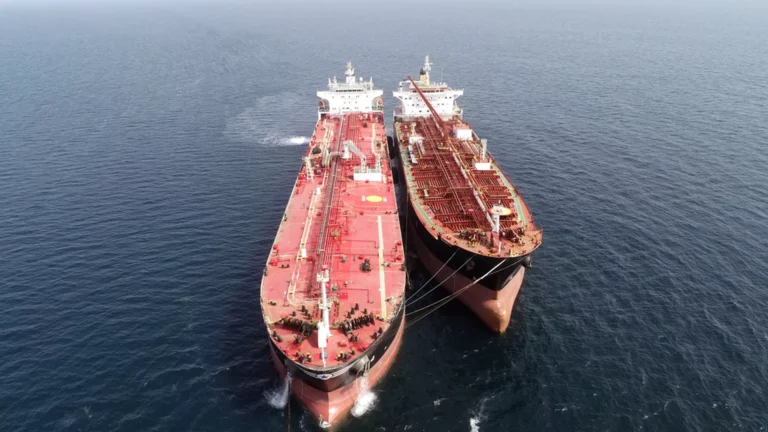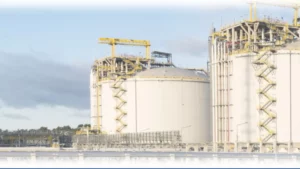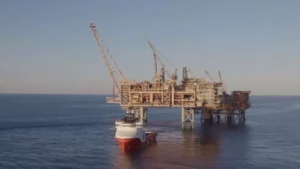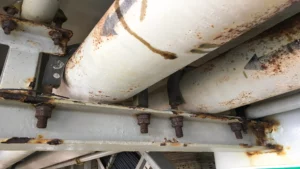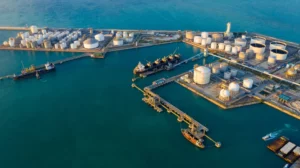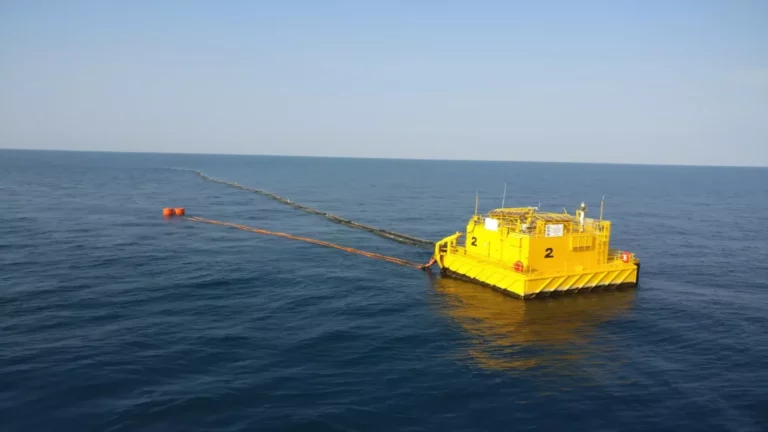Introduction
In a world where maritime trade plays a crucial role in the global economy, Ship to Ship Transfers (STS) acquire fundamental importance. This method involves transferring cargo between vessels at sea and is vital for the efficiency and agility of maritime transport, especially in the hydrocarbons sector.
These operations allow for a more flexible and rapid distribution of essential resources such as oil and its derivatives, which is crucial given the dynamism and fluctuating demand of global markets. The ability to perform effective and safe transfers not only optimizes transport times and costs but also strengthens global energy security. Unraveling the intricate network of processes, technology, and regulations that support STS transfers underscores their irreplaceable impact on modern maritime trade.
What is a Ship to Ship operation?
Ship to Ship Tranfers or operations (STS) are maritime procedures in which two vessels are positioned parallel, either anchored or moving, to transfer cargo from one to another. This technique is predominantly used for transporting hydrocarbons and chemicals, although it is also used for other types of liquid cargoes. The precision in coordination and the ability to operate under various climatic conditions make STS operations a strategic and flexible option for maritime trade.
The types of vessels involved typically include oil tankers of various classes, such as VLCCs (Very Large Crude Carriers), and smaller ships, such as Aframaxes or Panamaxes, depending on the volume of the cargo. The vessels are equipped with specialized mooring and fendering systems that protect the structures during transfer, mitigating the impact between them. Additionally, a range of pumps and hoses designed to effectively handle large-scale liquid flow are used, ensuring a safe and efficient process.
Below is a video courtesy of Teekay Corporation, demonstrating the ship-to-ship transfer operation, from deploying fenders to hose connection and cargo transfer: this is how an STS process looks like.

Ship-to-ship oil transfer operation.
In terms of technology, STS operations use advanced monitoring and control systems to ensure precision and safety. This includes the use of GPS and radar systems for exact positioning of the vessels, as well as real-time communication technologies between crews. These technological components are crucial for adjusting operations to changing sea conditions and ensuring the safety of the transfers.
Moreover, these operations require strict adherence to international protocols and best practices recommended by organizations such as the International Maritime Organization (IMO), ensuring that each transfer meets the highest standards of environmental and operational safety. STS operations are not only fundamental to the logistics of hydrocarbon trade but also represent a technical and operational challenge that underscores the sophistication of modern maritime trade.
What is maritime trade?
Maritime trade is the exchange of goods and services via sea routes, using ships and other waterborne vessels. It is one of the oldest and most essential forms of international trade, allowing connections between countries and continents in an economical and efficient manner. Approximately 90% of the world’s trade is carried out by sea, highlighting its crucial role in the global economy.
The importance of maritime trade lies in its ability to transport large volumes of goods at low cost. Commodities such as crude oil, minerals, grains, and manufactured goods traverse the oceans daily, making maritime trade a fundamental pillar for economic growth and stability. Furthermore, this mode of trade fosters competitiveness by allowing access to different markets and raw materials, in addition to promoting efficiency through the optimization of global supply chains.

Ship to ShipTransfers (STS) play a vital role in this system, facilitating maritime transport logistics, especially in the handling of liquids and gases. These operations allow direct transfer of cargoes between vessels without the need to dock at ports, which can result in significant time and cost savings. For instance, a tanker transporting crude from the Middle East can transfer part of its load to a smaller vessel at a transshipment point, enabling the crude to be delivered to ports that cannot accommodate large ships. This not only improves efficiency and reduces transportation costs but also enhances the flexibility and adaptability of maritime trade to market fluctuations and demand.
It can be said, then, that maritime trade is a backbone of the global economy, and Ship to Ship Tranfers (STS) are an essential tool that enhances its effectiveness and adaptability, demonstrating the intricate interdependence between maritime transport practices and contemporary economic demands.
Loading and unloading operations
Loading and unloading in the context of Ship to Ship (STS) are complex technical procedures that require precise coordination and the use of advanced technology to ensure the safe transfer of cargo between vessels. These operations are conducted while the vessels are either anchored or adrift, using robust transfer hoses and specialized mooring systems that ensure stability during the process.

From a technical perspective, the process begins with the careful approach of the vessels, which must maintain a safe distance to prevent collisions. Once in position, marine fenders are deployed between the vessels to prevent damage to the hulls. The loading hoses, which are flexible yet extremely resistant to pressure and the transported product, extend from the loading vessel to the receiving vessel. During the transfer, the flow rate and pressure are constantly monitored to adapt to the receiving vessel’s capabilities and the marine conditions.
In terms of safety and regulations, STS operations are rigorously regulated by international conventions such as MARPOL Annex I, which sets specific guidelines to prevent pollution during oil transfers. Additionally, the International Maritime Organization (IMO) provides regulations that include the design and equipment necessary for the vessels to minimize risks. These standards ensure that both the crew and the environment are protected during operations.
Successful examples of Ship to Ship Transfers (STS)
- Shell Trading and Shipping Company: Shell has conducted STS operations in various regions, including the North Sea and the Caribbean. These operations allow Shell to optimize its crude supply chain, facilitating the transfer of oil to different refineries around the world according to demand fluctuations and prices.
- BP Shipping: BP conducts STS transfers to manage the transport of crude from production areas to points where it is processed or stored. BP employs strict safety procedures and cutting-edge technology to ensure the integrity of its operations, which has allowed them to maintain an impressive safety record.
- Teekay Corporation: Teekay is another major shipping company that frequently conducts STS operations, especially in regions where ports cannot accommodate large vessels. Teekay specializes in the logistics of oil and chemical products, and its STS operations are fundamental to facilitating global trade.
These companies are leaders in implementing and refining practices that comply with the most demanding international regulations, ensuring operations that are not only effective but also safe and environmentally responsible.
Impact on maritime trade and hydrocarbon transfer
Ship to Ship transfers (STS) of hydrocarbons are crucial for the dynamics of maritime trade, significantly impacting both operational efficiency and the economy of this sector. These operations enable the flexible mobility and handling of large volumes of crude and refined products, essential for responding to market fluctuations and global energy demands.
Efficiency and economy of maritime trade
The implementation of STS operations can drastically reduce waiting times at congested ports and allow for the use of more direct and economical trade routes. By enabling large vessels, such as VLCCs (Very Large Crude Carriers), to transfer part of their cargo to smaller ships, access is facilitated to ports that could not receive large-draft vessels. This not only optimizes transport routes and reduces logistical costs but also minimizes the risks associated with transporting large volumes of hydrocarbons near coasts and environmentally sensitive areas.
Specificities of hydrocarbon transfer
The transfer of hydrocarbons between vessels requires meticulous precision and control to prevent contamination and ensure safety. Specialized hoses and mooring systems are used that must comply with strict international regulations, such as those set by the International Maritime Organization (OMI). Additionally, operations must be supervised by trained personnel, and the presence of certified transfer supervisors is often required to ensure compliance with all safety and operational measures.
Benefits and challenges
Some important benefits are listed below:
- Logistical Flexibility: Facilitates the global management and distribution of hydrocarbons.
- Cost Reduction: Minimizes costs associated with port delays and transportation.
- Enhanced Safety: Allows operations in more controlled and secure locations at sea.
The following challenges are considered among the most significant:
- Environmental Risks: The risk of spills and contamination remains a major concern, requiring extremely rigorous safety protocols.
- Technological Dependence: The need for specialized equipment and highly trained personnel can increase operational costs.
- Strict Regulations: Navigating through the complex network of international regulations can be a logistical and administrative challenge.
Conclusions
In this article, we have explored the essentiality and complexity of Ship to Ship transfers (STS) in the context of global maritime trade. STS transfers not only optimize the efficiency and economy of maritime transport by allowing flexible cargo transfers between vessels, but they are also crucial for safely handling products like hydrocarbons directly at sea. This significantly reduces the times and costs associated with port transits and improves adaptability to changing market needs.
The importance of these operations transcends mere logistics; they profoundly impact the global economy, especially in sectors dependent on crude and refined products. However, despite their benefits, STS transfers present significant challenges, from the need to comply with strict international regulations to managing the environmental and safety risks associated with transferring potentially hazardous substances.
Looking to the future, technological evolution will continue to play a crucial role in the development and improvement of these operations. The adoption of advanced technologies for monitoring, safety, and operational efficiency will be key to addressing both existing and emerging challenges. Thus, the maritime sector must continue its commitment to innovation and sustainability to ensure that STS operations remain a vital and effective component in the landscape of global maritime trade.
References
Own source.



